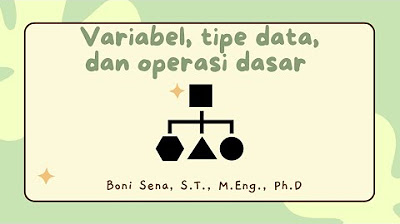BAID MK1 P3
Summary
TLDRThe lecture introduces the basics of string data types in Python, covering how strings represent characters, words, or sentences within variables. The instructor explains string declaration, indexing, slicing, and methods such as concatenation and repetition of strings. The lesson also touches on string-specific functions like 'find', 'len', and changing case using Python methods. Students are encouraged to practice coding in Google Colab or VS Code, with an emphasis on understanding variable creation, indexing, and string manipulation in real-time coding demonstrations.
Takeaways
- 🖥️ The lecture introduces the third meeting of the *Fundamentals of Programming* course, focusing on Python's string data type.
- 🔤 Strings in Python represent sequences of characters, which can include letters, numbers, and symbols, enclosed in single or double quotes.
- 📋 The session covers string indexing and slicing, explaining that indexing in Python starts from 0 rather than 1.
- ➕ String concatenation can be performed using the `+` operator, and repetition can be achieved using the `*` operator.
- 📚 Variable declarations in Python store values, and variables containing strings can be manipulated using various string methods.
- 🔍 Demonstration of indexing and slicing shows how to extract specific characters or substrings from a string using bracket notation.
- 🔎 The `find` method in Python helps locate the index of a specific character or substring within a string.
- 📊 Various string methods such as `len()`, `upper()`, and `lower()` are discussed to analyze and manipulate string data.
- 💡 The script demonstrates using Google Colab and Jupyter Notebook for coding in Python, comparing them to VS Code for local and online coding.
- 💻 Google Colab is recommended for users without a local development environment, as it allows coding directly in a web browser and on mobile devices.
Q & A
What is a string in Python?
-A string is a data type in Python that represents a sequence of characters. It can contain letters, numbers, symbols, or even entire sentences and is enclosed in either single or double quotes.
How are strings represented in Python?
-Strings in Python are represented as sequences of characters enclosed in either single quotes (') or double quotes (").
What is the difference between using single and double quotes in Python strings?
-Both single and double quotes can be used to define a string in Python, but they cannot be mixed. For instance, starting a string with double quotes and ending it with a single quote will result in an error.
How do you declare a variable with a string value in Python?
-To declare a variable with a string value, you assign the string to the variable. For example: `a = 'Hello World'`.
What is string indexing, and how does it work in Python?
-String indexing refers to accessing individual characters in a string. In Python, indexing starts at 0 for the first character. You can use positive indexes to access characters from the start and negative indexes to access characters from the end.
What is string slicing in Python?
-String slicing allows you to extract a part of a string by specifying a range of indexes. For example, `string[0:5]` would return the substring starting from index 0 up to but not including index 5.
How can strings be combined in Python?
-Strings can be combined using the `+` operator to concatenate them or the `*` operator to repeat them multiple times. For example, `'Hello ' + 'World'` results in `'Hello World'`.
What are some common string methods in Python?
-Common string methods include `find()`, which returns the index of a substring, `len()`, which returns the length of the string, and `upper()` and `lower()`, which convert the string to uppercase or lowercase.
How can you check the type of a variable in Python?
-You can check the type of a variable using the `type()` function. For example, `type(a)` will return `<class 'str'>` if `a` is a string.
What is the purpose of indexing with negative numbers in Python strings?
-Negative indexing allows you to access characters from the end of the string. For instance, `-1` refers to the last character, `-2` to the second last, and so on.
How does Python handle string storage in Google Colab?
-When coding in Google Colab, the string data or any code created is automatically stored in the user's Google Drive. This requires ensuring that the Drive is active and files are regularly backed up.
Outlines

This section is available to paid users only. Please upgrade to access this part.
Upgrade NowMindmap

This section is available to paid users only. Please upgrade to access this part.
Upgrade NowKeywords

This section is available to paid users only. Please upgrade to access this part.
Upgrade NowHighlights

This section is available to paid users only. Please upgrade to access this part.
Upgrade NowTranscripts

This section is available to paid users only. Please upgrade to access this part.
Upgrade Now5.0 / 5 (0 votes)





